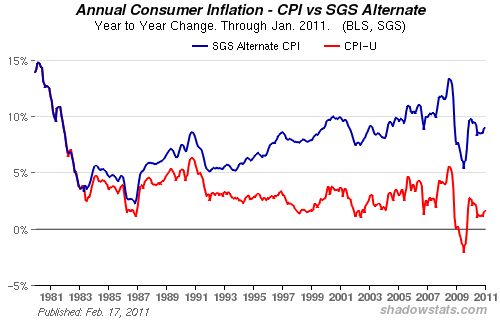Inflation Stalks CA Budgets
BY JOHN SEILER
Like a rerun of “That 70s Show,” inflation is back. And it’s hitting both personal and government budgets in California.
The most obvious signal of renewed inflation is the rise in prices at the gasoline pump. In just the past month, from Feb. 2 to March 2, 2011, average gasoline prices in California have risen from $3.36 a gallon to $3.81, or 13 percent. Over the past six months, prices have risen from $2.89 to $3.81, or 32 percent — nearly a buck a gallon.
Food commodity prices also have risen the past year: corn by 69 percent, coffee 65 percent, wheat 47 percent and soybeans 44 percent. According to NBC News, “We can anticipate higher prices for staples, such as sugar, butter, oats and oranges, as well as foods that contain these items and the commodities previously identified.”
By any measure imaginable, food prices are climbing and climbing fast and it’s not only in developing countries where income can’t keep up with the rise in the cost of goods.
Here in the US, food is putting a big bite on household budgets. More than 12 percent of after-tax income is now being spent on fuel and food, with more than half that number on the latter.
CNBC recorded these average price rises for consumers at grocery stores; monthly figures first, annualized second:
-
- Ground beef up 6.8 percent month over month, and 11.1 pct year over year.
- Butter, up 3.2 percent monthly and a stunning 27 percent over the past year.
- Coffee, up 6.5 percent and 16 percent.
- Potatoes, up 3.6 percent and 7.1 percent.
- Lettuce actually fell 5 percent monthly after a spike higher in December, but is up 5 percent over the past year.
- Bread up 1 percent and 3 percent.
- Chicken up 0.8 percent. and 4.3 percent .
- Egg prices have been fairly steady.
- Milk, down slightly month over month, but up 2 percent year over year.
Government budgets straining
With state and local budgets already struggling with deficits, this is the worst time possible for them also to deal with rising prices. Gov. Jerry Brown’s January budget proposal forecast, “Inflation is likely to be low for some time. However, cost pressures will remain.” That’s already out of date.
“Any changes would be part and parcel of the May Revision” of the budget, H.D. Palmer told me; he’s Deputy Director for External Affairs at the California Department of Finance. “Obviously it’s a very fluid situation.” The May Revision is due in the second week of May.
Those who deal with local food and fuel budgets definitely are concerned. “It would be too soon for us to see anything at the state level,” Phyllis Bramson told me; she’s director of nutrition services at the California Department of Education. “It may be felt at the local level. They get a set amount [of money] from the federal level. If they get X-dollars per pupil, but food costs go up 5 to 6 percent, ultimately the U.S. Department of Agriculture will raise that reimbursement amount. But it always lags a year behind.”
The USDA itself, which administers the food-stamp program, send me a Fact Sheet that explains what it’s telling school districts:
A perspective on fuel costs came from Ryan Gray, editor-in-chief of School Transportation News. “It’s affecting school districts’ day-to-day operations,” he told me. “A lot of them have pretty tight budgets.” He said that no numbers currently are available.
Schools especially are affected by prices of diesel, the fuel used by 95 percent of school bus fleets. According a March 2 report by the U.S. Energy Information Administration, “Diesel prices rose for the thirteenth consecutive week with the U.S. average retail price adding more than 14 cents to last week’s price. At $3.72 per gallon, diesel is $0.86 per gallon higher than last year at this time.”
Gray said that schools don’t pay that much for their diesel because, as government agencies, they get rebates of around $1 a gallon for the taxes paid on the fuel. “But still, when you add up all the mileage put on a school bus, the increased cost does add up.”
Well-run districts, he added, have dealt with price increases of past years and are preparing for new increases. School transportation departments increasingly are using routing software and GPS systems to maximize bus routes so the buses are not “dead heading,” meaning running without students in them.
Although governments will be affected differently, all are aware of the inflation. “Unlike some of our districts [in Orange County], we do not have a large fleet of vehicles that we are required to fuel and maintain,” Renee Hendrick told me; she’s Executive Director, Business Services at the Orange County Department of Education. “Though rising gas prices are affecting the cost fuel and increasing our food costs this is not a major expense for our district. We will be budgeting to anticipate higher costs in these areas.
“Due to the major reduction in state funding, this is just one more area that we need to find ways to reduce our expenditures.”
More inflation to come
Unfortunately, this is only the beginning of the inflation. The best analysis of why inflation occurs is that of the Austrian school of economics; it’s not about the country of Austria per se, but is named after where the economists came from who started the school more than 100 years ago.
The Austrian school says that, when a central bank prints too much money, inflation ensues, as does a boom-bust economic cycle. That’s what we’ve seen the past decade in America. In particular, the recent “Quantitative Easing” by America’s central bank, the Federal Reserve, has forced prices up.
The current economic “recovery” in the United States is only the result of the Fed “pumping” money into the economy. It is artificial and can’t last.
And although official jobless numbers are falling, as I reported last September on CalWatchDog.com, the government deliberately undercounts unemployment. If those one includes those who have quit searching for work, or are marginally employed, the real unemployment number is around 25 percent in California.
The most accurate unemployment numbers come from ShadowStats.com. The site also provides the most accurate inflation numbers, as reflected in their chart at the top of the page. Unfortunately, U.S. government statistics today have become too politicized.
The bottom line is that, just like citizens and businesses, governments had better prepare for higher prices for many years to come. If one goes by the price of gold, the dollar’s value has declined from $275 an ounce of gold in 2001 to more than $1,400 today, 10 years later.
Gold keeps setting record highs in prices. That means, the Austrian school would say, that the Federal Reserve’s “quantitative easing” — inflation — is not over. Nor is the increase in prices of fuel, food and other goods used by governments.
John Seiler is CalWatchDog.com’s managing editor. His email: writejohnseiler@gmail.
Related Articles
Lawmakers work with industry to improve ride-sharing
State lawmakers have shelved a plan to adopt new regulations on the state’s burgeoning ride-sharing industry in favor of industry-backed
SoCal Senate race narrows, Democrats edge closer to supermajority
Republicans’ chances of fending off a Democratic supermajority in the Legislature dwindle by the day. The linchpin is one Southern California
CA ‘anchor baby’ debate goes national
Republican presidential candidates were drawn deeper into the immigration controversies centered on California, as Donald Trump’s leading opponents sought a




